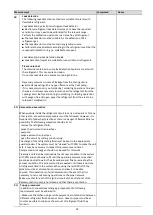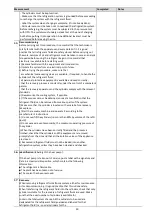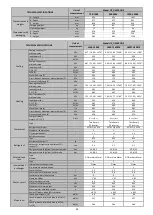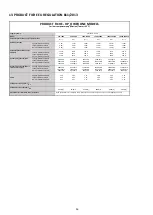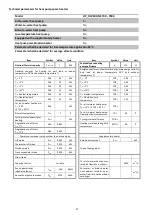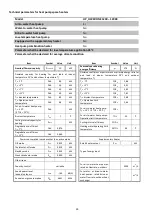
24
10.1
CLEANING THE FINNED COIL
To correctly clean the coil, follow the instructions below:
a) Remove any superficial filth. Debris such as leaves, fibres etc. must be removed without a vacuum cleaner (use a brush or
another soft tool carefully avoiding scratching with metal or abrasive parts). If you use compressed air, pay attention to keep the
air flow perpendicular to the surface of the coil in order not to bend the aluminium fins. Pay attention not to bend the fins with
the nozzle of the compressed air lance.
b) Rinse. Rinse with water. It is possible to use chemical substances (specific detergents for finned coils). Rinse the coils by letting
the water run inside each individual passage of the fins, until they are perfectly clean. Pay attention to direct the water jet
perpendicular to the surface of the coil in order not to bend the aluminium fins. Do not strike the coil with the water hose. Apply
your thumb at the end of the hose to increase the pressure of the water jet instead of using specific nozzles which could damage
the coil.
10.1.1
Cleaning the finned coils treated with the anti-corrosion method
The anti-corrosion treatment applied to the finned coils guarantees protection against aggressive atmospheres.
The frequency of cleaning depends on the environmental conditions and is left to the common sense of the maintenance staff.
When oxidizing dust or grease particles are observed on the battery surface, cleaning is recommended. In general, in a slightly
polluted atmosphere, it is recommended to carry out the cleaning treatment every three months.
Washing should be carried out with preferably hot water (40-60 °C) and detergent with neutral pH, while rinsing is carried out with
abundant fresh water (50 l / m
2
).
If the maintenance staff observes a lack of protective cover on the edge of the fins, it is necessary to contact the nearest
assistance center to proceed with a new application of the cover and completely restore the protection against corrosion.
CAUTION: Do not clean the coil using high-pressure cleaners so as not to apply excessive pressure which could cause
irreparable damage. Damage caused by cleaning with unsuitable chemical substances or excessively high water
pressure will not be recognised under warranty.
CAUTION: The aluminium fins are thin and sharp. Pay the utmost attention and use appropriate PPE to avoid cuts
and abrasions. Cover your eyes and face appropriately to avoid squirting water and filth while blowing. Wear
waterproof shoes or boots and clothing covering your entire body.
For units installed in aggressive atmospheres with a high fouling rate, cleaning of the coil must be part of the routine
maintenance program. In these types of installations, all of the dust and particulates deposited on the coils must be
removed as soon as possible through regular cleaning according to the methods shown above.
10.2
EXTRAORDINARY MAINTENANCE
All extraordinary maintenance jobs must be carried out by an authorised assistance centre.
10.3
ENVIRONMENTAL PROTECTION
Legislation regulating the use of substances harmful for the ozone layer establishes the prohibition of releasing refrigerant gases
into the environment. In fact at the end of their service life, these must be retrieved and handed over to specific collection
facilities. The R32 refrigerant is mentioned among substances subject to the special controls set forth by law and therefore must
abide by the obligations indicated above.
Special attention is therefore recommended during maintenance so as to reduce
refrigerant leaks as far as possible.
11
DECOMMISSIONING
Once the unit has reached the end of its life cycle and needs to be replaced, the following operations are recommended:
•
the refrigerant has to be recovered by trained personnel and sent to proper collection centres;
•
any antifreeze additives in the water circuit must be recovered and disposed of properly;
•
the compressors’ lubricating oil has to be collected and sent to proper collection centres;
•
the electronic components, such as regulators, driver boards and inverters, must be disassembled and sent to proper collection
centres;
•
the structure and the different components, if unusable, must be scrapped and divided according to their nature; there is
especially a good amount of copper and aluminium in the machine.
These operations allow easy material recovery and the recycling process, thus reducing the environmental impact.
The user is responsible for the proper disposal of this product, according to national regulations in the country of destination of
the appliance. For more information you should contact the Installation Company or local competent authority.
Summary of Contents for HP_OWER ONE 120R
Page 2: ......
Page 55: ...54 CHILLER MODE DOMESTIC HOT WATER MODE Cooling ...
Page 61: ...60 18 REGISTER OF OPERATIONS OF MAINTENANCE ...
Page 62: ...61 5 ...
Page 63: ......




















